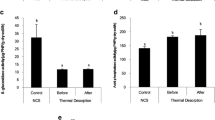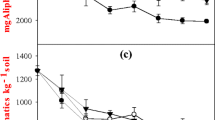Abstract
Polluted soils in temperate regions are frequently exposed to seasonal freezing and thawing events during which the soil biological properties are expected to change in response to the associated temperature variations. In this study, we investigated the influence of freeze–thaw events on enzymatic activities and natural attenuation of petroleum hydrocarbons in temperate soils with varying pollution profiles. Four soils [clean natural, Diesel amended (DAS), Crude-oil amended (COAS), and aged oil polluted] were subjected to ten freeze–thaw temperature regimes ranging from − 20 to + 20 °C for 45 days. The soil enzymatic activities and fractional petroleum hydrocarbon analysis were conducted using spectrophotometry and gas chromatography–mass spectrometry, respectively. After the incubation period, freezing resulted in decreased enzyme (lipase and dehydrogenase) activities in both clean and polluted soils, while thawing events compensated for the enzymatic losses that occurred during the preceding freezing phase. Fractional hydrocarbon analysis revealed that there was a switch from active removal of light- to medium-chain hydrocarbons (C10–C23) in the short-term polluted soils (DAS and COAS) during the freezing phase to rapid degradation of the heavier nonvolatile hydrocarbon fractions (C23–C34) during the thawing phase, and the long-term polluted soil had lower hydrocarbon removal rates than the short-term polluted soils. The relationship between the natural attenuation of hydrocarbons in the oil polluted soils and incubation temperatures was linear in the short- and long-term petroleum polluted soils.


Similar content being viewed by others
References
Abellan MA, Baena CW, Morote FAG, Cordoba MIP, Perez DC (2011) Influence of the soil storage method on soil enzymatic activities in Mediterranean forest soils. Plant Soil Environ 20(3):379–388
Abena MTB, Li T, Shah MN, Zhong W (2019) Biodegradation of total petroleum hydrocarbons (TPH) in highly contaminated soils by natural attenuation and bioaugmentation. Chemosphere 234:864–874
Aislabie J, Saul DJ, Foght JM (2006) Bioremediation of hydrocarbon-contaminated polar soils. Extremophiles 10(3):171–179
Alrumman SA, Standing DB, Paton GI (2015) Effects of hydrocarbon contamination on soil microbial community and enzyme activity. J King Saud UnivScie 27(1):31–41
Bajagain R, Gautam P, Jeong S (2020) Degradation of petroleum hydrocarbons in unsaturated soil and effects on subsequent biodegradation by potassium permanganate. Environ Geochem Health 42:1705–1714
Blagodatskaya E, Blagodatsky S, Khomyakov N (2016) Temperature sensitivity and enzymatic mechanisms of soil organic matter decomposition along an altitudinal gradient on Mount Kilimanjaro. Sci Rep 6:22240
Børresen MH, Barnes DL, Rike AG (2007) Repeated freeze-thaw cycles and their effects on mineralization of hexadecane and phenanthrene in cold climate soils. Cold RegSciTechnol 49(3):215–225
Buddhadasa C, Barone S, Bigger S, Orbell J (2001) Extraction of hydrocarbons from clay soils by sonication and soxhlet techniques. Sekiyu Gakkaishi J Jpn Pet Inst 44(6):378–383
Burns RG, DeForest JL, Marxsen J, Sinsabaugh RL, Stromberger ME, Wallenstein MD, Weintraub MN, Zoppini A (2013) Soil enzymes in a changing environment: current knowledge and future directions. Soil BiolBiochem 58:216–234
Chandra S, Sharma R, Singh K, Sharma A (2013) Application of bioremediation technology in the environment contaminated with petroleum hydrocarbon. Ann Microbiol 63:417–431
Chang W, Klemm S, Beaulieu C, Hawari J, Whyte L, Ghoshal S (2011) Petroleum hydrocarbon biodegradation under seasonal freeze-thaw soil temperature regimes in contaminated soils from a sub-arctic site. Environ SciTechnol 45(3):1061–1066
Chen W, Li J, Sun X, Min J, Hu X (2017) High efficiency degradation of alkanes and crude oil by a salt-tolerant bacterium Dietzia species CN-3. IntBiodeteriorBiodegrad 118:110–118
Chikere CB, Okpokwasili GC, Chikere BO (2011) Monitoring of microbial hydrocarbon remediation in the soil. Biotech 1:117–138
de Abreu-Mota MA, de MouraBarboza CA, Bícego MC, Martins CC (2016) Sedimentary biomarkers along a contamination gradient in a human-impacted sub-estuary in Southern Brazil: a multi-parameter approach based on spatial and seasonal variability. Chemosphere 103:156–163
Dong YW, Somero GN (2009) Temperature adaptation of cytosolic malate dehydrogenases of limpets (genus Lottia): differences in stability and function due to minor changes in sequences correlate with biogeographic and vertical distributions. J Exp Bio 212:169–177
Dzionek A, Dzik J, Wojcieszyńska D, Guzik U (2018) Fluorescein diacetate hydrolysis using the whole biofilm as a sensitive tool to evaluate the physiological state of immobilized bacterial cells. Catalysts 8:434
Ekperusi OA, Aigbodion FI (2015) Bioremediation of petroleum hydrocarbons from crude oil contaminated soil with the earthworm, Hyperiodrilus africanus. Biotech 3:957–965
Eriksson M, Ka JO, Mohn WW (2001) Effects of low temperature and freeze-thaw cycles on hydrocarbon biodegradation in Arctic tundra soil. Appl Environ Microbiol 67(11):5107–5112
Ferguson SH, Franzmann PD, Revill AT, Snape I, Rayner JL (2003) The effects of nitrogen and water on mineralisation of hydrocarbons in diesel-contaminated terrestrial Antarctic soils. Cold RegSciTechnol 37:197–212
Gheju M (2011) Kinetics of hexavalent chromium removal with scrap iron in continuous-flow system. Chemical Bulletin of Politehnica 56(70):1–7
Gkorezis P, Daghio M, Franzetti A, Van Hamme JD, Sillen W, Vangronsveld J (2016) The interaction between plants and bacteria in the remediation of petroleum hydrocarbons: an environmental perspective. Front Microbiol 7:1836
Guo WL, Shi HB, Ma JJ, Zhang YJ, Wang J, Shu WJ, Zhang ZY (2013) Basic features of climate change in North China during 1961–2010. Adv Climate Change Res 4(2):73–83
Han L, Tsunekawa A, Tsubo M (2010) Monitoring near-surface soil freeze–thaw cycles in northern China and Mongolia from 1998 to 2007. Int J Appl Earth ObsGeoinf 12(5):375–384
Henry A (2007) Soil freeze–thaw cycle experiments : Trends, methodological weaknesses and suggested improvements. Soil BiolBiochem 39:977–986
Holden P, LaMontagne M, Bruce A, Miller WG, Lindow SE (2002) Assessing the role of Pseudomonas aeruginosa surface-active gene expression in hexadecane biodegradation in sand. Appl Environ Microb 68:2509–2518
Joseph B, Shrivastava N, Ramteke PW (2012) Extracellular cold-active lipase of Microbacterium luteolum isolated from Gangotri glacier, western Himalaya: isolation, partial purification and characterization. J Genet EngBiotechnol 10(1):137–144
Kaczyńska G, Borowik A, Wyszkowska J (2015) Soil Dehydrogenases as an indicator of contamination of the environment with petroleum products. Water Air Soil Pollut 226:372–376
Kim J, Lee AH, Chang W (2018) Enhanced bioremediation of nutrient-amended, petroleum hydrocarbon-contaminated soils over a cold-climate winter: the rate and extent of hydrocarbon biodegradation and microbial response in a pilot-scale biopile subjected to natural seasonal freeze-thaw. Sci Total Environ 612:903–913
Koshlaf E, Ball AS (2017) Soil bioremediation approaches for petroleum hydrocarbon polluted environments. AIMS Microbiol 3(1):25–49
Leahy JG, Colwell RR (1990) Microbial degradation of hydrocarbons in the environment. Microbiol Rev 54(3):305–315
Maletić SP, Dalmacija BD, Roncevic SD, Agbaba JR, Perovic SDU (2011) Impact of hydrocarbon type, concentration and weathering on its biodegradability in soil. J Environ Sci Health, Part A 46:1042–1049
Margesin R (2005) Determination of enzyme activities in contaminated soil. In: Margesin R, Schinner F (eds) Soil biology: manual for soil analysis, vol 5. Springer-Verlag, Berlin Heidelberg, pp 309–320
Margesin R, Zimmerbauer A, Schinner F (2000) Monitoring of bioremediation by soil biological activities. Chemosphere 40(4):339–346
Margesin R, Feller G, Hämmerle M, Stegner U, Schinner F (2002) A colorimetric method for the determination of lipase activity in soil. Biotech Lett 24:27–33
Margesin R, Hammerle M, Tscherko D (2007) Micobial activity and community composition during bioremediation of diesel-oil contaminated soil: effects of hydrocarbon concentration, fertilizers and incubation time. MicrobEcol 55:259–269
McKew BA, Coulon F, Osborn AM, Timmis KN, McGenity TJ (2007) Determining the identity and roles of oil-metabolizing marine bacteria from the Thames estuary. UK Environ Microbiol 9:165–176
Michael K, Wasswa J, Kasozi G (2016) Removal efficiency of total petroleum hydrocarbons from water by Pseudomonas aeruginosa: a case of lake albert. Uganda J BioremedBiodeg 7:337–341
Miura M, Jones TG, Hill PW, Jones DL (2019) Freeze-thaw and dry-wet events reduce microbial extracellular enzyme activity, but not organic matter turnover in an agricultural grassland soil. Appl Soil Ecol 144:196–199
Mrozik A, Piotrowska-Seget Z (2010) Bioaugmentation as a strategy for cleaning up of soils contaminated with aromatic compounds. Microbiol Res 165(5):363–375
Naga Raju M, Golla N, Vengatampalli R (2016) Soil Physicochemical Properties Soil Enzymes 2016:5–10
Nikrad MP, Kerkhof LJ, Max MH (2016) The subzeromicrobiome : microbial activity in frozen and thawing soils. FEMS MicrobiolEcol 92(6):1–16
Razavi BS, Blagodatskaya E, Kuzyakov Y (2015) Nonlinear temperature sensitivity of enzyme kinetics explains canceling effect—a case study on loamy haplicLuvisol. Front Microbiol 6:1126
Robinson PK (2015) Enzymes: principles and biotechnological applications. Essays Biochem 59:1–41
Rončević S, Dalmacija B, Ivančev-Tumbas I, Tričković J, Petrović O, Klašnja M, Agbaba J (2005) Kinetics of degradation of hydrocarbons in the contaminated soil layer. Archives of Environ ContamToxicol 49(1):27–36
Schnurer J, Rosswall T (1982) Fluorescein diacetate hydrolysis as a measure of total microbial activity in soil and litter. Appl Environ Microbiol 43:1256–1261
Sihag S, Pathak H, Jaroli DP (2014) Factor affecting the rate of biodegradation of polyaromatic hydrocarbons. Int J Pure ApplBiosci 2:185–202
Smith JL, Halvorson JJ, Bolton H (2002) Soil properties and microbial activity across a 500m elevation gradient in a semi-arid environment. Soil BiolBiochem 34:1749–1757
Steinweg JM, Jagadamma S, Frerichs J, Mayes MA (2013) Activation energy of extracellular enzymes in soils from different biomes. PLoS ONE 8(3):e59943
Trasar-Cepeda C, Leiros MC, Seoane S, Gil-Sotres F (2000) Limitations of soil enzymes as indicators of soil pollution. Soil BiolBiochem 32:1867–1875
Truskewycz A, Gundry TD, Khudur LS, Kolobaric A, Taha M, Aburto-Medina A, Ball AS, Shahsavari E (2019) Petroleum hydrocarbon contamination in terrestrial ecosystems-fate and microbial responses. Molecules 24(18):3400
Varjani SJ, Upasani VN (2017) A new look on factors affecting microbial degradation of petroleum hydrocarbon pollutants. IntBiodeteriorBiodegrad 120:71–83
Wu M, Dick WA, Li W, Wang X, Yang Q, Wang T, Chen L (2016) Bioaugmentation and biostimulation of hydrocarbon degradation and the microbial community in a petroleum-contaminated soil. IntBiodeteriorBiodegrad 107:158–164
Yang SZ, Jin HJ, Wei Z, He RX, Ji YJ, Li XM (2009) Bioremediation of oil spills in cold environments: a review. Pedosphere 19(3):371–381
Yao Y, Huang GH, An CJ, Cheng GH, Wei J (2017) Effects of freeze-thawing cycles on desorption behaviors of PAH-contaminated soil in the presence of a biosurfactant a case study in western Canada. Environmental Science: Processes and Impacts 19(6):874–882
Zekri A, Omar C (2005) Effect of temperature on biodegradation of crude oil. Energy Sources Part A 27:233–244
Zhou J, Huang R, Cheng S, Tang J, Fan H (2018) Effects of bacterial-feeding nematodes and organic matter on microbial activity and oil degradation in contaminated soil. Environ SciPollut Res 25:35614–35622
Acknowledgement
The authors are grateful for the financial support from the National Water Pollution Control and Treatment Science and Technology Major Project (No. 2018ZX07109-003) of China. The first author is grateful to the Petroleum Development Trust Fund, Nigeria, for the doctoral scholarship award.
Author information
Authors and Affiliations
Corresponding author
Additional information
Editorial responsibility: Samareh Mirkia.
Supplementary Information
Below is the link to the electronic supplementary material.
Rights and permissions
About this article
Cite this article
Okonkwo, C.J., Liu, N., Li, J. et al. Experimental thawing events enhance petroleum hydrocarbons attenuation and enzymatic activities in polluted temperate soils. Int. J. Environ. Sci. Technol. 19, 1185–1196 (2022). https://doi.org/10.1007/s13762-021-03175-8
Received:
Revised:
Accepted:
Published:
Issue Date:
DOI: https://doi.org/10.1007/s13762-021-03175-8




